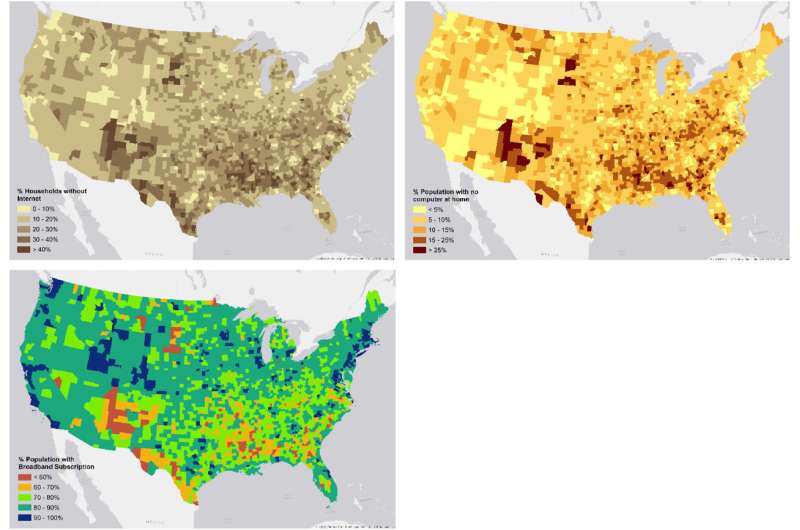Researcher shows connection between digital divide and COVID-19 outcomes

Two years into the pandemic, U.S. counties with lower home internet or computer access levels were seeing higher COVID-19 case and death rates, according to research by Fei Li, an assistant professor of urban studies at Georgia State University.
"There's a substantial gap between those who can and those who cannot benefit from information and communication technologies," said Li, who uses spatial econometric methods to analyze how digital exclusion, like the lack of internet access, is related to disparities in COVID-19 outcomes.
Many U.S. residents don't have home computers or broadband internet subscriptions, which limits their access to the most up-to-date public health guidelines, including social distancing, masking, testing and early treatment, and increasingly popular telemedicine services.
U.S. counties with a higher percentage of people identified as "digitally excluded" saw higher COVID-19 case and death rates throughout the pandemic and lower vaccination rates in late 2021 and early 2022. This outcome suggests increased vulnerability among this population to future disease.
Li's findings suggest a targeted effort from governments, public health agencies and health care providers is needed to provide resources for digitally disadvantaged individuals and communities. Her work calls upon these decision-makers to recognize the significant implications of digital exclusion and marginalization during the pandemic.
Additionally, legislatures, regulators and providers can be called to reform digital platforms, especially those that serve as the primary source of information for people with limited digital access or literacy, such as social media, to reduce misinformation and information silos.
Finally, Li advocates investments in more accessible and equitable internet infrastructure and digital literacy education. The Infrastructure Investment and Jobs Act poses an opportunity to close the gap between the technology haves and have-nots and allow every resident to take full advantage of technology to obtain accurate and timely information, receive goods and services, maintain social and emotional support, and alleviate health risks in a pandemic.
The research is published in the journal Health & Place.
Further research is needed to understand how the digital divide affected the COVID-19 pandemic's impact. However, to reduce health disparities related to digital exclusion, policymakers must recognize broadband internet as an essential service and critical infrastructure in this digital era and ensure that these technologies are accessible and affordable to all.
More information: Fei Li, Disconnected in a pandemic: COVID-19 outcomes and the digital divide in the United States, Health & Place (2022). DOI: 10.1016/j.healthplace.2022.102867



















